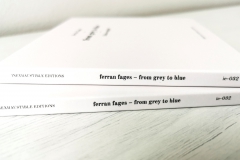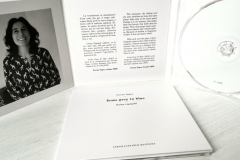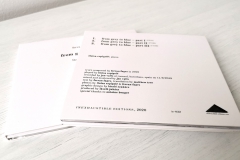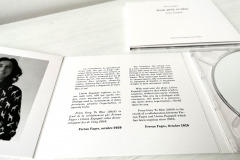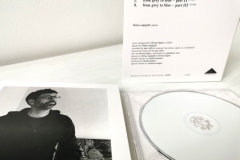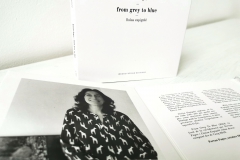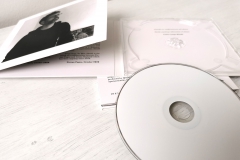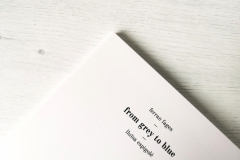Ferran Fages – From Grey To Blue
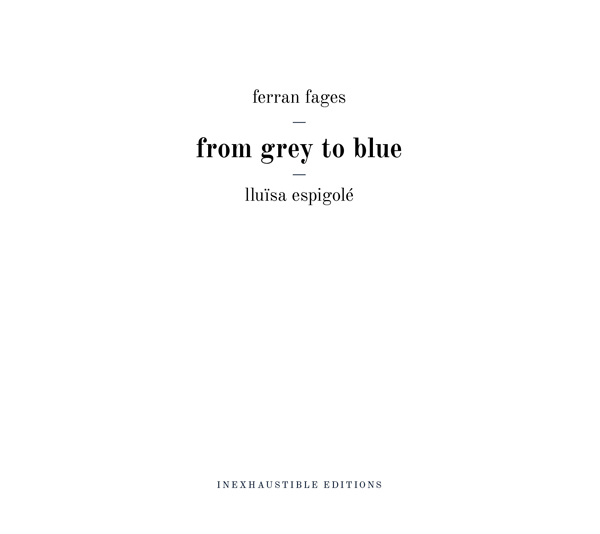
1. From Grey To Blue – Part I (12:51)
2. From Grey To Blue – Part II (17:35)
3. From Grey To Blue – Part III (11:00)
· Lluïsa Espigolé: piano
Score composed by Ferran Fages in 2018
Played by Lluïsa Espigolé
Recorded by Jan Valls at Rosazul, Barcelona, Spain on 11/9/2019
Mixed and mastered by Jan Valls
Text by Ferran Fages, translation by Matthew Tree
Photos by Lluïsa Espigolé & Ferran Fages
Graphic design by László Szakács
Produced by László Juhász
Special thanks to Antoine Beuger
La ressonància, la ralentització d’una nota, fan que el temps esdivingui llarg; però les notes sempre es fonen amb la mateixa rapidesa. És, potser, la nostra memòria qui les fa eternes, qui les reté més temps. Desendrecen llocs coneguts, connecten espais, endrecen llocs desconeguts, filaments d’ombra o fragments de llum. Tan se val.
Lluïsa Espigolé captura, en tocar cada nota, allò que queda suspès, sense moviment, sense emoció. Dialoga amb la ressonància, li dóna presència, alenteix l’espectativa, si aquesta hi fos.
From Grey To Blue (2018) és fruit de la col·laboració que Ferran Fages i Lluïsa Espigolé estan desenvolupant des de l’any 2016.
Ferran Fages
octubre 2020
The resonance, the ticking over of a note, stretches out time; but notes always fade away at the same speed. Perhaps it is our memory that makes them last forever, that holds them for longer. They disarrange known places, connect spaces, tidy unknown places, filaments of shadow or fragments of light. It does not matter which.
With each note she plays, Lluïsa Espigolé captures that which is left in suspense, without movement, without emotion. She sets up a dialogue with resonance, she gives it a presence, she slows down expectations, should there be any.
From Grey To Blue (2018) is the result of a collaboration between Ferran Fages and Lluïsa Espigolé which has been ongoing since 2016.
Ferran Fages
October 2020
Gairebé res: malformacions del silenci / Barely anything: deformities of silence
Carles Camps Mundó
Released: December 2020 / first edition of 300 cds
Direct purchase: Bandcamp / Discogs
GALLERY ↓
REVIEWS ↓
“Zjawisko rezonansu wydaje się być kluczowe w trakcie naszych dzisiejszych, barcelońskich spacerów. Teraz jednak obcować będziemy z nim w nieco innym wymiarze – diametralnie spokojniejszym i dalece bardziej … rozrzedzonym. Zapraszamy na trzy minimalistyczne utwory na fortepian solo, które eksplorować będą efekt rezonujących dźwięków, wydobywanych z wielkiego instrumentu za pomocą klawiatury. W roli podmiotu wykonawczego wystąpi pianistka Lluïsa Espigolé. Kompozycje Ferrana Fagesa zarejestrowano jesienią 2019 roku w miejscu zwanym Rosazul, położonym rzecz jasna w Barcelonie. Całość trwa 41 i pół minuty.
Cisza od początku do końca nagrania zdaje się być pełnoprawnym elementem spektaklu. Oddziela od siebie akordy, zarówno te niemal pojedyncze, jak i te zebrane w skromne plejady. Wyznacza kilkunastosekundowymi pauzami przestrzeń pomiędzy poszczególnymi kompozycjami. Rządzi i dzieli, a nade wszystko dba o to, by generowane przez pianistkę dźwięki mogły odpowiednio długo wybrzmiewać i rezonować z instrumentem, głuchą przestrzenią miejsca nagrania, tudzież ze skrzypiącym krzesełkiem, na którym siedzi artystka.
Pierwsza część wydaje się być szczególnie dostojna. Cisza, akord, cisza, akord, a pomiędzy nimi swobodne wybrzmiewanie. W trakcie utworu sekwencje akordów ulegają zmianie, ale fakt ten bywa chwilami zupełnie niedostrzegalny. W drugiej części narracja ulega jeszcze większemu rozrzedzeniu. Przestrzeń dla echa rośnie, ilość dźwięków maleje. W połowie utworu kilka bardziej zwartych uderzeń w czarne klawisze, zaserwowanych przez pianistkę, to niemal zmiana konwencji. Szczęśliwie dla miłośników gatunku, naprawdę chwilowa. Z kolei trzecia kompozycja przynosi nam więcej dźwięków w jednostce czasu. Plastry rezonansu i cisza pomiędzy nimi stają się przez to nieco krótsze, mniej majestatyczne. Narracja płynie raz nisko, innym razem nieco wyżej, czym także podnosi minimalny tu przecież poziom emocji. A ostatnie dźwięki definitywnie należą do czarnej części klawiatury.” / Andrzej Nowak, Trybuna Muzyki Spontanicznej, 29 December 2020
“Thanks to my habit of neglecting to read the sleeve notes, I only just realised that all three albums here are from Inexhaustible Editions. Also thanks to this habit, I was completely unprepared for Nick Ashwood’s solo release Unfolding/Overlay. I glanced over it, saw ‘acoustic guitars’ and figured we’d get to hear a solo approach as heard on his group improvised efforts, so my first listening was spent mostly getting over the shock of how it sounded. A steely tambura drone opens the album-length piece, which I figured was going to be the groundwork for some trancey guitar noodling until it gradually dawned on me that this was the trancey guitar stuff. Ashwood’s made this piece from two long, unedited takes of bowing on an acoustic guitar and then superimposing them. As performance, it’s a meditative experience, at once introspective yet open-minded, with the slow but purposeful drifting that comes from bringing the mind to an alert passivity through concentrated action. As a composition, the listener hears the constant weaving of bowed chords as a single, braided strand, with illusory harmonies and timbres and breathing pulses that can become either strong or frail, simple or complex, always evolving into something new of its own accord.
Just a small spoiler: the first fifteen seconds of Ferran Fages’ From Grey To Blue are silent. You might want to keep that in mind before cranking the volume. Not that the piece is loud, but it is clearly present: a forty-minute work for a full and closely-miked piano, played by Lluïsa Espigolé. Thinking back to Fages’ Un lloc entre dos records, a work for solo guitar and sine tones, and remembered that it was difficult to get a grip on: “The mind struggles to reconcile the parts into a whole”. Fages pushes the unresolved shapes of his music even further here, perhaps past breaking point. The piece falls into three parts, but in each the phrases are brief and widely separated by silences. Fages and Espigolé have collaborated over a couple of years and her playing, although described in the notes as “without emotion”, captures something tentative, even reluctant to proceed. At least there’s no sentimentality, even though the gently paced combinations of single tones and minor chords (rarely more than dyads) could lend themselves to drama. In the central section, the sounds themselves seem to thin out; when more chords return in part three everything happens more slowly. It’s described as a study in resonances and the spaces between sounds, but I’m usually pretty skeptical of pieces which make a virtue of reticence. With each successive listening, however, the sounds start to feel more tied together and playing it loud reveals the piano mechanism at work and the voids start to fill in as though they’re making some sort of connection; but as to what those connections might be, I’m not sure.
Fages is also part of the group TRUSS, playing acoustic guitar and feedback with Alejandro Rojas-Marcos on clavichord and Bárbara Sela on recorders. Todos los animales se reúnen en un gran gemido is a set of seven tracks recorded on one day in late 2019. They are apparently group improvisations but I keep hearing Fages’ methods at work. There are sustained high, keening passages as heard in his earlier piece Radi d’Or and, as the album progresses, the sounds start to break up into irresolute fragments. It’s stupid to attribute this to one musician when there are three at work. It sounds like Rojas-Marcos is using various extended techniques on his instrument, complicating the picture of who plays what when paired with Fages’ guitar. Sela’s recorder can either lead or shadow the high-pitched bowing and feedback, or otherwise derail and obstruct the continuity, forcing new approaches. The way the tracks are sequenced, the early sections are distinct and sometimes busy in that conventional group improv way, but around halfway through things become more fraught, with the music never quite succumbing to silence but always on the verge of breaking up, all the same. It’s not a comfortable experience, but it asks more questions of the listener than I originally bargained for.” / Ben Harper, Boring Like A Drill., 21 January 2021
“From Grey To Blue was written by Fages for fellow-Catalan, contemporary experimental pianist Lluïsa Espigolé, known for her work with contemporary composers like Helmut Lachenmann and Peter Ablinger. This composition was inspired by a short quote by Catalan author Carles Camps Mundó: ‘Barely anything: deformities of silence’. This composition was conceived in a collaborative process between Fages and Espigolé between 2016 and 2018 and recorded at Rosazu in Barcelona in September 2019.
As on other works from Fages, the focus here is on the resonant qualities of sounds, including the silent spaces between sounds. The sounds in this minimalist and extremely slow composition are suspended in time and space, almost without any movement, and intentionally devoid of emotion or drama but reaching their most expressive statements in the third and last part. This composition challenges Espigolé to find meaning and even dialog with this kind of almost static sounds, in and within the single tones and in relation to the piano.
Espigolé does so brilliantly. The sonic and emotional emptiness becomes the very essence of this meditative journey. There is nothing more than the suchness of the resonant sounds. And Espigolé lets these sounds suggest elusive dimensions and courses of time, tricks our listening sensibilities into believing that these sounds can last forever, and weaves these sounds in the unknown, arresting spaces, with shifting, delicate angles of light and shadow.” / Eyal Hareuveni, The Free Jazz Collective, 19 March 2021
“Something entirely different is the music by Ferran Fages and Lluïsa Espigolé. She gets the credit for playing the piano and as with the release by Duplant and Tentelier, I would think this is another fruitful interaction between composer and performer, with the latter becoming co-composer. The pieces are slow and minimal. Like Duplant/Tentelier, this is an album about space we find between the notes, as everything unfolds in a rather slow manner. Or, maybe it’s better to say it doesn’t unfold and the music doesn’t go anywhere. It is just there. The notes and the (almost blank) spaces between just exist, as dots on an otherwise blank canvas, or stars in the sky. Espigolé plays the piano with some sustain, and she too waits uses that sustain to great effect. Sometimes until it all died down, or overlapping some of these pieces with an extra note or two. It is not an album that is all about silence with just a few notes. It is all rather present; this isn’t silenced for the sake of silence, but to leave enough space in between and let the listener in a more contemplative mood. I like the way we hear the piano chair, very occasionally, allowing for a small crack and as such, that is perhaps a human element. It has not been cleaned up, but it makes for a rather private session, like being present while recording, trying to be silent, and you know that fails. And yet none of that disturbs the proceedings and note for note the music continues a wonderfully strange trajectory. Now, this is surely something modern classical.” / Frans de Waard, Vital Weekly, 20 April 2021
“Ci-dessous, extrait des notes de pochette de From Grey To Blue.
‘The resonance, the ticking over of a note, stretches out time; but notes always fade away at the same speed. Perhaps it is our memory that makes them last forever, that holds them for longer. They disarrange known places, connect spaces, tidy unknown places, filaments of shadow or fragments of light. It does not matter which. With each note she plays, Lluïsa Espigolé captures that which is left in suspense, without movement, without emotion. She sets up a dialogue with resonance, she gives it a presence, she slows down expectations, should there be any. From Grey To Blue (2018) is the result of a collaboration between Ferran Fages and Lluïsa Espigolé which has been ongoing since 2016.’
Une composition en trois parties du gris au bleu (12:51 – 17:35 – 11:00) écrite par Ferran Fages pour la pianiste Lluïsa Espigolé dont j’appécie particulièrement la qualité de toucher et la force d’interprétation de l’oeuvre. Issu de la scène improvisée – expérimentale, le guitariste Ferran Fages, connu pour son travail dans la mouvance réductionniste – lower case, conçoit des musiques focalisées sur des intentions et des buts soigneusement délimités. Ici la mort lente du son du piano dans le silence en cultivant la résonance, la plasticité du son dans l’espace. L’ensemble composition – exécution – réalisation technique est optimal. Bon nombre d’improvisateurs radicaux ont rejoint les rangs des compositeurs « conceptuels » réunis dans la mouvance Edition Wandelweiser et Another Timbre, sans doute parce qu’ils ressentaient une limitation ou un blocage dans la démarche improvisée libre. Certains improvisateurs finissent sans doute par se répéter, d’autres ont la capacité d’étendre leurs moyens et de se/nous surprendre au fil des ans. Quoi qu’on fasse, il y a toujours une part d’inconnu si on en a la détermination. Et cet aspect des choses est bien ressenti dans From Grey To Blue. Félicitations à Ferran Fages, à la pianiste Lluïsa Espigolé et à l’équipe d’Inexhaustible Editions.” / Jean-Michel Van Schouwburg, Orynx-improv’andsounds, 5 May 2021
“When discussion turns to a pianist’s touch, it’s tempting to think mainly of what they do with their fingers. But it must be said that Lluïsa Espigolé exhibits some next-level footwork on this realization of Ferran Fages’ From Grey To Blue. Fages is a multi-instrumentalist who functions equally persuasively within the realms of electroacoustic improvisation and heavy jazz-rock, but for this piece, which was devised specifically for Espigolé, he uses written music and an instrument he doesn’t play, the piano, to engage with resonance and melody. The three-part composition advances with extreme deliberation, often one note at a time, turning the tune into a ghostly presence and foregrounding the details of the decay of each sound. This music is so sparse that the shift to chords in the third section feels dramatically dense after a half hour of single sounds and corresponding silences. The elements of this music have been sculpted with such exquisite control that one wonders if Catalonia has looked into insuring Espigolé’s feet; her way with the piano’s pedals is a cultural resource.” / Bill Meyer, Dusted Magazine, 30 July 2021
“Ferran Fages is the excellent Spanish fellow from Barcelona whose diverse work appears here every so often, most recently in 2018 as part of the trio Phicus, but it was the Atolón record from 2004 which continues to be a personal benchmark for my mouldy lugs, made with Alfredo Costa Monteiro and Ruth Barberan. Their dry and highly severe take on acoustic improvisation left a taste in mouth as palpable as a diet of dusty twigs. Fages played the ‘acoustic turntable’ on that pivotal item, which I always assumed was either a hand-cranked victrola, or a modern turntable that wasn’t plugged in.
Well, over time our man has evolved into a composer, and in 2018 he released examples of his composerly craft for both Another Timbre and Edition Wandelweiser, which I mention as it could give you a signpost as to the stars that guide his chosen aesthetic sailing ship. His From Grey To Blue, in my hands today, was played by Lluïsa Espigolé, a very determined modernist whose repertoire favours composers from the 20th and 21st centuries, and who also engages with multi-media performances, electronics, video, prepared piano, somehow finding time to occupy the professor chair of contemporary piano and chamber music at the University Of Music in Zaragoza. Today’s work, structured in three parts, was composed in 2018 but Fages indicates that the collaboration with Espigolé was going on for two years before that, so the deep resonances of the music have evidently had a long gestation period, and what emerges from the slow and deliberate tones is something very distilled. Ferran Fages seems to have become fixated on the idea of a single musical event, that of a note decaying and fading away. In that near-microscopic happening, he seems to perceive grand truths about the nature of the universe.
The pianist here has the impossible task of ‘capturing that which is left in suspense’, called upon to enter into a dialogue with the idea of resonance itself. Any emotion or movement in the performance mus be checked in at the cloakroom; as she sculpts this fragile ‘presence’ from thin air, the listener’s expectations are either slowed down to a glacial rate, or dispensed with completely. Phew. Not even Samuel Beckett would have given such severe, hard-to-follow instructions to an actor appearing in his absurd dramas. To cap it all, we’ve a very poignant printed quote here about the nature of ‘nothingness’ from Carles Camps Mundo, the experimental Catalan poet who sometimes deigned to use language, but is also known as a concrete / visual poet. He seemed to be one who has an absolute horror both of silence; and of words; what else can we make of the lament that speaks of ‘carnivorous muteness’ and ‘That powerful silence that annoys me’?
Summa, this delicate piece of music may seem to have one or two of the Wandelweiser hallmarks that dog my life so much, yet we have to admire the purity of Fages and his vision, and the remarkable poise and elegance – some might call it superhuman restraint – exhibited by pianist Lluïsa Espigolé as these eerie, half-alive notes emanate stiffly from the other side, hang in the air mysteriously, and fade away like spectres.” / Ed Pinsent, The Sound Projector, 7 January 2022
RADIO PLAYS ↓
· No Wave at Tilos Rádió, Budapest, 30 May 2021
· Crow With No Mouth at CWNM Radio, Hager City, Wisconsin, 24 June 2021
· Glasni Novi Svet at ARS – 3. Program Radia Slovenija, Ljubljana, 20 October 2021
· The Sound Projector Radio Show at Resonance FM, London, 21 January 2022

